Protein skimmer
A protein skimmer is one piece of equipment that you may not be familiar with. It is an additional form of filtration that mechanically removes proteins and waste from salt water. It does this by creating lots of tiny bubbles inside that become coated with protein, and then overflow into a collection cup. The collection cup can be emptied and cleaned periodically, removing waste from the system.
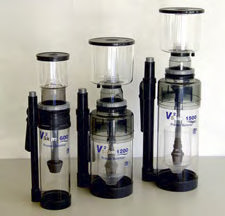
Why you need a protein skimmer?
Traditional filters break down waste by converting ammonia to nitrite and then nitrate. We remove the end product, nitrate, by changing water. In an aquarium you don’t want any ammonia, nitrite or nitrate, and a protein skimmer helps by removing it at the source.
Marine fish and invertebrates will not tolerate any pollution in the water, and a protein skimmer acts a primary, mechanical filter. Skimmed water is cleaner and healthier.
Protein skimmers can mean a higher start-up cost when keeping marines, but their benefits are well documented and many of the world’s best marine aquariums are filtered using this method. Some marine aquariums don’t use any other form of filtration apart from a protein skimmer and live rock. This method is called the Berlin System, and more information will be available from the marine expert in store.
Powerheads
A trip to your nearest coastline, or watching a marine nature documentary, will reveal that the oceans are constantly moving, be it from wave action, currents or the Gulf Stream. Marine life is totally dependant on water movement to bring them their food and wash away their waste, and that movement should be replicated in the aquarium.
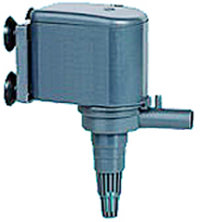
Flow is provided by pumps, filters and powerheads. Calculate the total volume of your aquarium and provide enough turnover to pump the entire water volume ten to twenty times per hour. This will be sufficient for most corals, fish and invertebrates. If you use an external filter and protein skimmer, the flow from these devices can also be factored in, so an aquarium of 180 l. / 40 gal volume, for example, should have a turnover of 1800 lph / 400 gph or more.
Hydrometer
An essential piece of equipment when keeping marines. A hydrometer tells us how salty the tank water is, and we need to know this because marine life needs a certain level of salt in the water to survive.
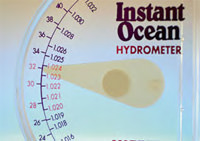
We make up our own salt water at home by mixing pure, fresh water, preferably RO water, with synthetic sea salt. To tell us how salty the water is, we use a hydrometer. This usually consists of a plastic box with a swing needle inside, or a floating object that looks a bit like a thermometer. Whenever you use a hydrometer to measure salt levels, make sure you bring the water to the correct temperature first.
Filtration
This area is dealt with in a different way to freshwater filtration. Marine reef aquariums require the best possible water quality at all times, and most use a combination of filtration and protein skimming to achieve that.
An external filter packed with mechanical, biological and chemical filtration is a good start, and is essential for most fish-only marine tanks where fish are the focus and no invertebrates are added, but the majority of modern reef aquariums are actually filtered primarily by live rock, with powerheads providing food and oxygen for bacteria, and the rough inner and outer surfaces of the rock providing a home for them to grow and multiply.
When lots of live rock is used, biological media can be removed from the filter and it can be replaced with important chemical media like carbon and phosphate remover.
Chiller
With bright lighting and lots of pumps and equipment, it is not heating that is the problem with most marine tanks, but cooling. High temperatures (over 27ºC/80ºF) can stress and even kill tropical marine life, so artificial cooling is the sensible long-term option.
A cost-effective cooling method is to use fans. Several small fans can be fitted to the top of the tank to blow cool air across the surface of the water. One can even be fitted on either side of the tank rim – one to blow cool air in and one to suck hot air out.

For larger aquariums, hot rooms and tanks that use very bright lighting, a chiller may be the only option. Chillers work like refrigerators, only they connect to the aquarium via pipework. The required temperature can be set on the chiller and it will work tirelessly to hold that temperature, venting off lots of heat as it does so.
A chiller must be connected to a either a powerhead in the main tank or an external filter underneath.
They are not cheap, but the cost can easily be offset when protecting a tank full of corals and fish from overheating.
Lighting
The majority of marine fish and invertebrates that we keep come from the warm, shallow seas of the tropics. For much of the day, coral reefs are exposed to full sunlight and it’s much brighter than we provide for most freshwater setups. Furthermore, most corals rely on the sunlight to give them their energy as they harbour algae called zooxanthellae, which need bright light in order to photosynthesize.
Lighting is available for marine tanks and it is generally brighter and of a different colour to freshwater lighting. Marine lighting tends to have a blue tinge to replicate the light available underwater.
This can be done by using a combination of daylight and actinic (blue) tubes, or by using light tubes that combine both types of light. You may need extra lighting for more demanding corals.
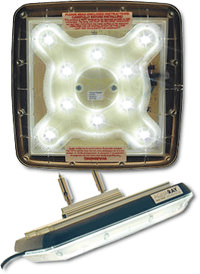
We also use more light for lighting marines, and we do that by using a number of standard light tubes, high-powered T5 light tubes or metal halide lighting – high-powered bulbs that are normally suspended over open-topped aquariums.
A minimum requirement for small tanks is two light tubes, preferably high-powered ones. For larger, deeper aquaria, four T5 tubes (two blue and two white) are normally necessary, and for the brightest light with the best effect, choose metal halide light in combination with actinic blue fluorescent light tubes.
As a rough guide, aim to provide one watt of lighting for every litre of water.
Ultra-Violet Steriliser
UVs can help to kill disease pathogens and parasites. Some marine fish like Powder Blue and Regal tangs are susceptible to marine whitespot, and the addition of a UV can help to prevent that.
UVs can be fitted below in a cabinet, above or behind an aquarium, and can work in conjunction with external filters, sumps or powerheads. They are also suitable for disease prevention in freshwater aquariums.
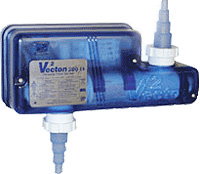
Change the bulbs regularly for maximum efficiency.
Tip: When choosing a marine set-up, make sure that the system can be fitted with all the necessary equipment. You can buy a systemised Aquarium with equipment already fitted, if you are unsure.
 British Pounds
British Pounds
